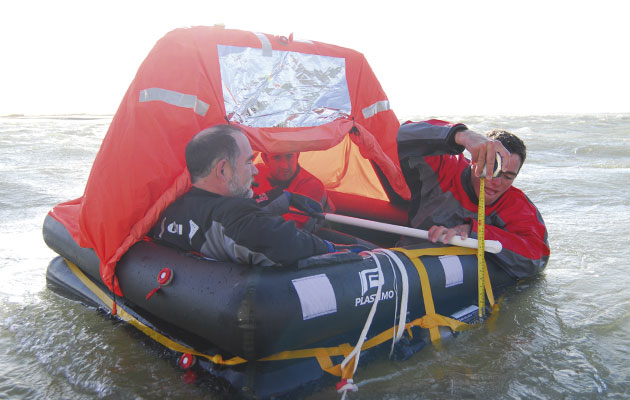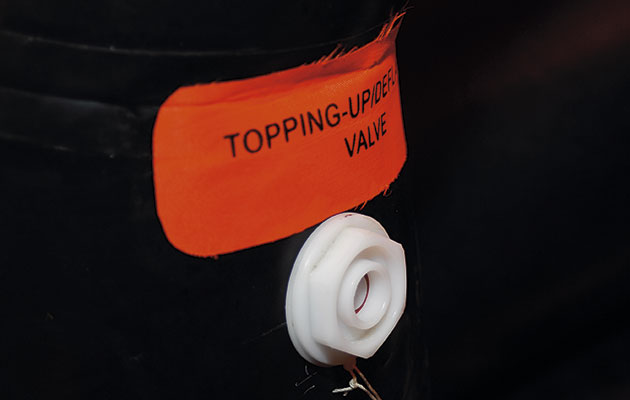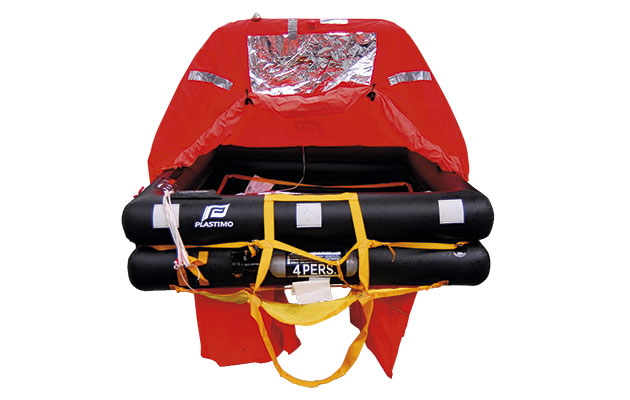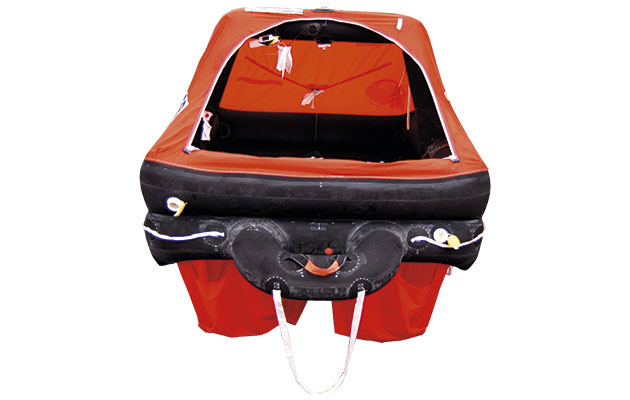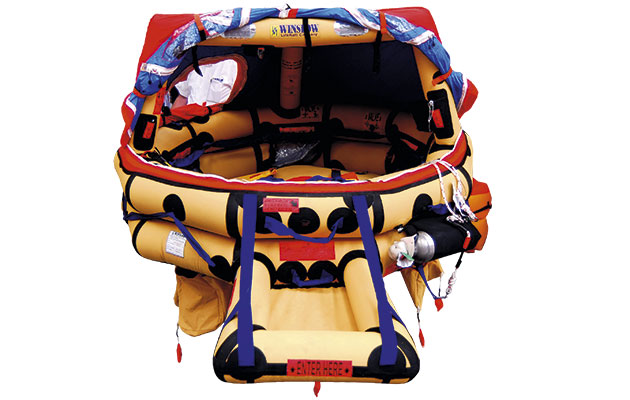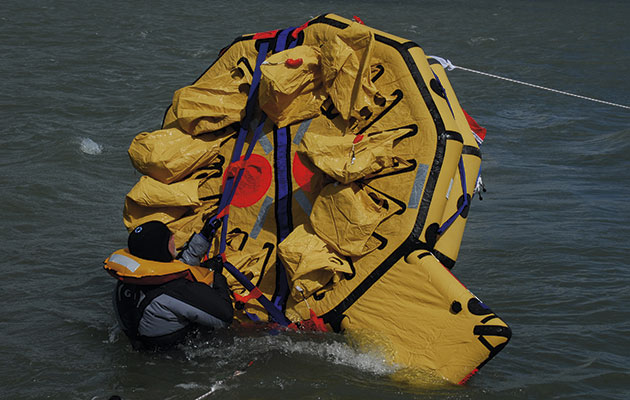Do manufacturers abide by the self-regulating ISO 9650 liferaft standard? Does the standard go far enough? Chris Beeson tests six liferafts to find out
Six ISO 9650 liferafts tested
Yachting’s greatest disaster was the 1979 Fastnet Race storm when 15 sailors died. Liferafts capsized and some even broke-up in the Force 10 seas. As a result, a new manufacturing standard for liferafts was established by the Offshore Racing Congress (ORC). Although it was admirable in intention it was lacking in detail – its requirements covering just half a page of A4 paper.
Twenty years on, the shortcomings of the ORC standard were exposed by the 1998 Sydney-Hobart Race, when another six lives were lost. The resulting inquiry demanded a leisure liferaft standard thorough enough to be the last word in liferaft design. In 2005 the ISO 9650 standard was ratified and implemented.
No law for liferafts
There’s no doubt that ISO 9650 marks a step forward in liferaft design, but it does have some fundamental problems. Get hold of some rubber, glue and a copy of the ISO 9650 specifications and anyone can make – and sell – an ISO 9650 liferaft.
While there are strict rules about the manufacture of yachts and lifejackets, ISO 9650 is self-regulating: legally, no one has to test whether a liferaft meets the standard. As a consumer, you are simply expected to take the manufacturer’s word that it does.
Our aim was to examine whether liferafts billed as ISO 9650-compliant really met the standard. We enlisted the RYA’s technical manager, Ken Kershaw, to help run the test.
Ken is Europe’s leading authority on non-commercial liferafts and one of the architects of ISO 9650.
We asked all the major dealers for a liferaft to test. Plastimo, Ocean Safety and Viking agreed, as did the American company Winslow, which is new to the European market. But despite repeated requests, Plastimar, Arimar, Avon and Zodiac Inflatables, Seago and RFD Beaufort declined to take part.
When asked why, Avon and Zodiac Inflatables said it could not participate in our test ‘due to the time of year and liferaft availability’. All others ignored our requests.
To ensure that the budget end of the market was represented in our trials, YM bought a Seago ISO 9650 self-righting four-man liferaft for £979 and ran it through some rigorous tests with five other liferafts.
The test
We conducted our test in Chichester Harbour, just inside East Head. The intention was to get as close to the ISO requirements as our resources would allow. The examination was divided into dynamic tests, carried out in the water, and static tests carried out on land.
Test team
- Ken Kershaw, now retired, was the RYA’s technical manager and a member of the ISO working group that drafted the ISO 9650 standard. He also helped design a liferaft standard for the International Sailing Association (ISAF), which governs yacht racing.
- YM’s assistant editor Chris Beeson spent four hours in a liferaft, adrift in Force 6 winds in the Bay of Biscay, which taught him much about life aboard a raft in open water. He is also author of The Handbook of Survival at Sea.
Dynamic tests
Launching test

The ISO 9650 standard specifies a launch height of 6m, a float-before-inflation time of 30 minutes, an inflation to final shape within 60 seconds, and an inflation to operating pressure within three minutes. For our test, we used a 42ft motorboat. The launch height was 3m – higher than it would be for any sailing yacht – and the float test was five minutes
Number of compartments
There must be at least two separate buoyancy compartments. If one chamber deflates, the liferaft must have positive buoyancy when occupied by four crew with an average weight of 75kg. This test, ISO says, should be conducted in a pool
Boarding from a height

This ISO test involves dropping a 75kg bag of sand onto the top of the liferaft from 3m above it, four times, to simulate boarding, and then checking for damage afterwards. We turned our noses up at a simulation – and got the crew to jump onto each liferaft from the back of the boat
Properties of the painter

The painter, according to the ISO, must be at least 9m in length, with a coloured section 1m from the end to indicate that it is close to the point of firing. It must be attached at the liferaft entrance in a way that ensures the liferaft will not be damaged should it fail
Righting test

Four crew in oilskins and inflated lifejackets swim 50m and then each rights one liferaft alone. This test is usually conducted in a swimming pool. As just two of us were testing six liferafts at sea in Spring tides, we wore drysuits
Boarding test

Crew must wear fully inflated lifejackets with at least 150N of buoyancy, although the RYA Basic Sea Survival course recommends partially deflating the lifejacket to make boarding the liferaft easier. Each crewmember must be able to board unaided
Carrying capacity
Loaded with four crew (average weight 75kg) and wearing lifejackets – or in our case three crew with an average of 83kg and a barrel of water – there should be ‘sufficient comfort and headroom’ inside. ISO 9650 specifies 4sqft (1.2sqm) per person. It sounds like a lot but mark it out and try sitting there for any length of time.
General stability
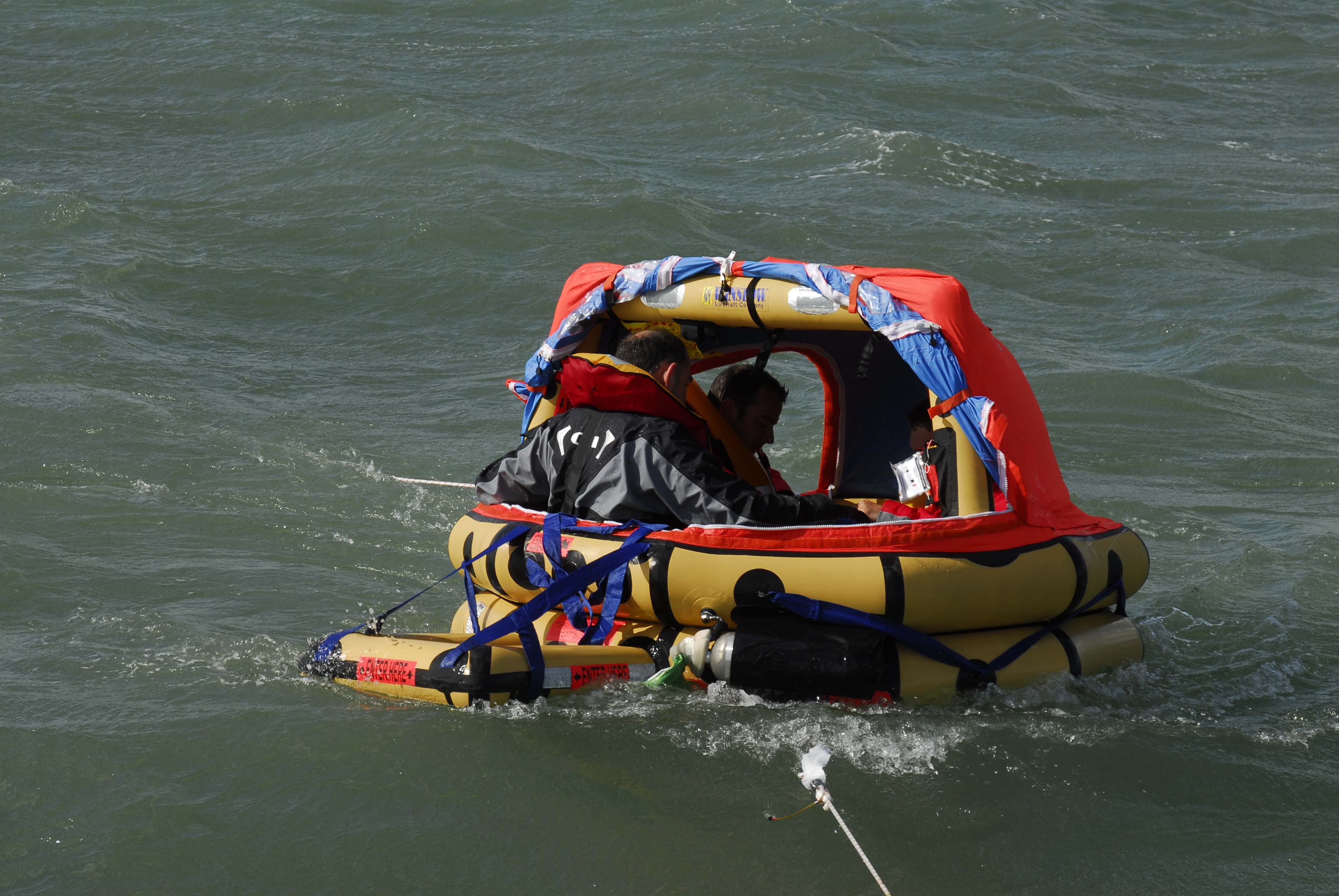
This tests stability in a seaway. The fully crewed, fully equipped liferaft is towed at 3 knots with the sea anchor deployed
Freeboard
Flooding resistance
With one of the buoyancy tubes deflated, the liferaft must have some remaining freeboard to prevent flooding.
Static tests
Look-out means
Floor
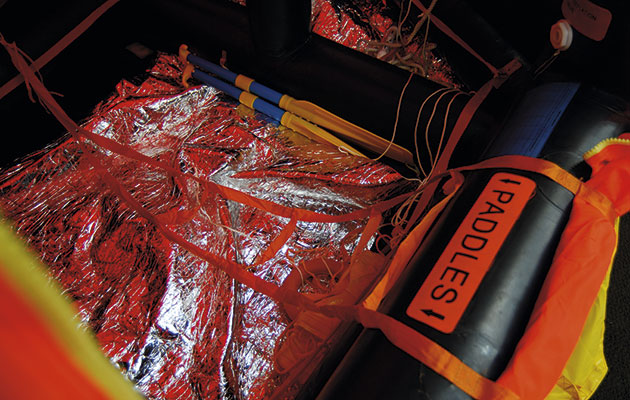
Floors must have thermal insulation. If insulation is by means of an inflatable floor it should remain airtight during use, and be able to be deflated and reinflated by the liferaft crew
Cordages and lifelines

Lifelines must offer non-slip grip. If rope, the diameter must be at least 8mm, if webbing, at least 25mm wide
Topping-up inflation valves
High-pressure hose assembly
Survival pack equipment

The survival pack must contain items specified in a list of minimum requirements. We looked at Survival Pack 1 (less than 24 hours)
- Portable, buoyant hand bailer
- 2 sponges
- 2 paddles tied into raft close to entrance
- First aid kit
- Whistle
- 2 waterproof torches with six-hours’ duration, plus spare bulb and batteries
- Signalling mirror
- 6 anti-seasickness pills, per person
- Sealable seasickness bags, one per person
- 6 red hand flares
- 2 red parachute flares
- 2 thermal protective aids
- Repair kit suitable for use during violent motion
- Inflation pump and captive adaptors
- 5 litres drinking water per person, containers less than 500ml each (or a desalinator) and a rainwater collection device
- 10,000 calories food per person
The results (prices correct in 2009)
Launching: Launched with a single, firm pull of the painter, which is located off to
one side of the entrance.

Righting: The liferaft righted easily using the righting strop, attached to three of
the four corners, and the rung of the boarding ladder
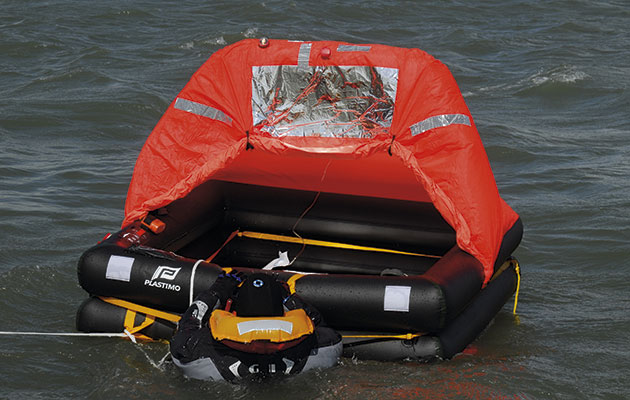
Boarding: Using the boarding ladder’s rung and the webbing hand-holds, boarding was fairly straightforward but the ballast bags didn’t stop the liferaft from heeling during boarding, lifting the bags clear of the water on a couple of occasions. Though boarding was easy, the boarding ramp offered no assistance. The gas bottle, between the boarding ramp and the buoyancy tube, didn’t appear to interfere with boarding
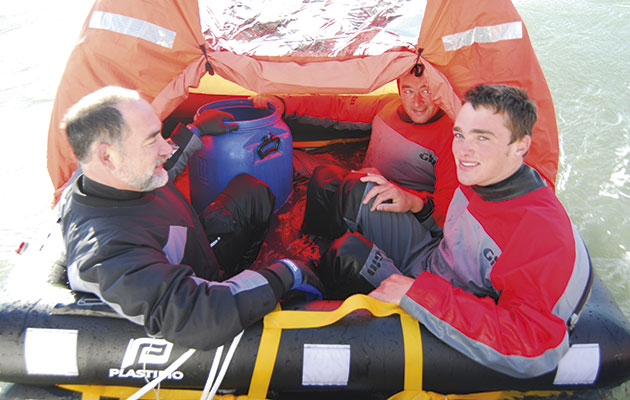
Inside: There is no stowage and labelling could be better. Headroom is limited but adequate at the edges of the liferaft, where survivors sit
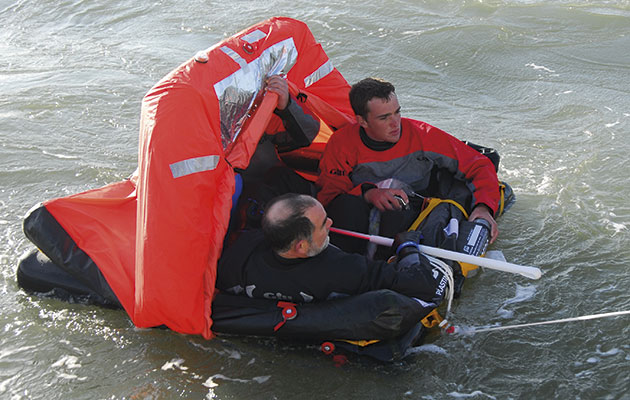
Buoyancy: The freeboard was only just above 25cm when fully loaded. There was positive buoyancy with one tube deflated
Equipment: Well packaged but labelling could be better and there was no stowage
for the equipment.
Independently tested: Yes, by Bureau Veritas.
Manufacturer’s comments:
Plastimo’s assisted firing head allows a child or casualty to inflate the liferaft easily, without fail. Boarding system efficiency is much better shown on larger liferafts with higher freeboard. Equipment labelling is not necessary because the pouch is transparent and its Velcro closure makes it re-usable and appropriate for stowage.
Data panel
Weight: 33.5kg
Dimensions: 74×47.5×26.5cm
Does it meet the standard?
6.2 LAUNCHING
Pulls on painter: 1
5-min float: Yes
Inflate to shape: 19 secs
Fully inflate: 40 secs
5.2.1.2 PROPERTIES OF PAINTER
At entrance: Yes
1m indicator: Yes (but light coloured)
Easy to fire: Yes
5.2.3.1 NUMBER OF COMPARTMENTS
2
5.2.5.4 BOARDING FROM A HEIGHT
Damage: None
6.5 RIGHTING TEST
Time: 4 secs
6.6 BOARDING TEST
Time: 14.5 secs (ave)
5.2.3.2 CARRYING CAPACITY
Sufficient comfort and headroom Yes
5.2.3.3 FREEBOARD
>250mm with four crew Yes (just, check in calm water)
5.2.4.1 STABILITY GENERAL
3-knot tow with four crew Yes (Fair, wet and windage bent canopy)
5.2.3.4 FLOODING RESISTANCE
Positive freeboard with one flat tube Yes (Good)
5.2.8.3 EQUIPMENT (<24HRS)
Pass
Viking Rescyou
Launching: Launched with a single pull of the painter it inflated very quickly. The two Viking liferafts tested were the quickest to inflate. In both Viking liferaft, the painter attachment is farther away from the entrance than others on test, which keeps it clear while boarding but would require more of a stretch if cutting the painter.

Righting: Righting was quick and easy using the righting loop attached to the underside of the liferaft. This liferaft and the Winslow were the only ones tested where the gas bottle was not behind or beneath the boarding ramp (below raft, right of entrance)

Buoyancy: Freeboard when fully loaded exceeded the 25cm minimum by 15cm and maintained positive buoyancy with one tube deflated
Equipment: Everything was well packaged and well labelled but there was little stowage. The sea anchor was the best on test although, at some stage during the course of several hours of testing and bouncing around, the 100ft line had been accidentally deployed and tangled around the painter attachment.
Independently tested:Yes, by Bureau Veritas.
Manufacturer’s comments:
Our range of leisure liferafts fully conform to the ISO 9650-1 standard. We have a worldwide network of Viking companies and service agents to ensure our liferafts are serviced to our exacting standards.
Data panel
Weight: 28kg
Dimensions: 77x34x34cm
Does it meet the standard?
6.2 LAUNCHING
Pulls on painter: 1
5-min float: Yes
Inflate to shape: 12 secs
Fully inflate: 16 secs
5.2.1.2 PROPERTIES OF PAINTER
At entrance: No
1m indicator: Yes
Easy to fire: Yes
5.2.3.1 NUMBER OF COMPARTMENTS
2
5.2.5.4 BOARDING FROM A HEIGHT
Damage: None
6.5 RIGHTING TEST
Time: 6.5 secs (ave)
6.6 BOARDING TEST
Time: 12 secs (ave)
5.2.3.2 CARRYING CAPACITY
Sufficient comfort and headroom Yes
5.2.3.3 FREEBOARD
>250mm with four crew Yes (>400mm)
5.2.4.1 STABILITY GENERAL
3-knot tow with four crew Yes (Good, drogue tangled)
5.2.3.4 FLOODING RESISTANCE
Positive freeboard with one flat tube Yes (Good)
5.2.8.3 EQUIPMENT (<24HRS)
Pass
Viking Rescyou Pro

Launching: The liferaft launched with a single pull of the painter and inflated very quickly. The painter attachment was low down at a corner and hard to reach from the entrance, so cutting it would be difficult

Righting: The liferaft self-righted quickly and couldn’t be deliberately inverted for any length of time

Boarding: The substantial boarding ramp worked well and the webbing rung didn’t float, making it easier to use. Hand-holds were well positioned
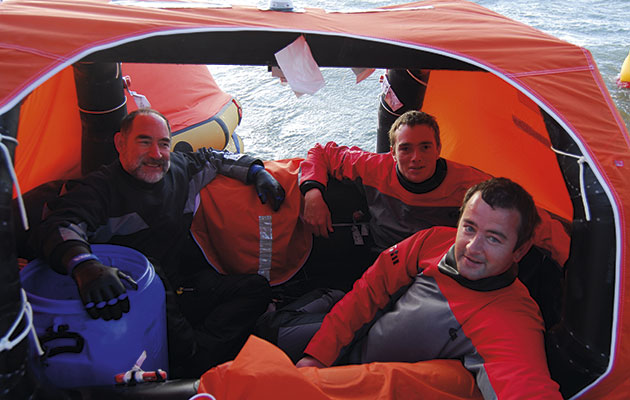
Inside: There was excellent headroom and more floor area than most of those on test. The inflatable floor adds comfort and insulates against the cold

Buoyancy: Freeboard when fully loaded exceeded the 25cm minimum by 11-15cm and easily maintained positive buoyancy with one tube deflated
Equipment: Everything was well packaged and well labelled but, like all except the Winslow, there was little stowage.
Independently tested:
Yes, by Bureau Veritas.
Manufacturer’s comments:
Our range of leisure liferafts fully conform to the ISO 9650-1 standard. We have a worldwide network of Viking companies and service agents to ensure our liferafts are serviced to our exacting standards.
Data panel
Weight: 33kg
Dimensions: 79x38x36cm
Does it meet the standard?
6.2 LAUNCHING
Pulls on painter: 1
5-min float: Yes
Inflate to shape: 9 secs
Fully inflate: 25 secs
5.2.1.2 PROPERTIES OF PAINTER
At entrance: No
1m indicator: Yes
Easy to fire: Yes
5.2.3.1 NUMBER OF COMPARTMENTS
2
5.2.5.4 BOARDING FROM A HEIGHT
Damage: None
6.5 RIGHTING TEST
Time: Self righting
6.6 BOARDING TEST
Time: 6 secs
5.2.3.2 CARRYING CAPACITY
Sufficient comfort and headroom Yes
5.2.3.3 FREEBOARD
>250mm with four crew Yes (360-400mm)
5.2.4.1 STABILITY GENERAL
3-knot tow with four crew Yes (Good)
5.2.3.4 FLOODING RESISTANCE
Positive freeboard with one flat tube Yes (Good)
5.2.8.3 EQUIPMENT (<24HRS)
Pass
Ocean Safety Ocean ISO
Launching: Launched with a single pull of the painter. Only the Viking liferafts inflated quicker.

Righting: Righting was easy using the stirrups for feet and the two straps on the underside of the liferaft. However, the packaged paddles floated free and the drogue deployed during the process

Boarding: This liferaft had the most effective webbing and rung boarding system tested, with a larger kneeboard and bars weighing down the rungs, making them sink to foot level. Hand-holds were well positioned

Inside: The yellow buoyancy chambers and the silver thermal insulation stitched onto the floor made it very bright inside, brighter than the Winslow and dazzling compared to the others. No stowage

Buoyancy: Fully loaded, the liferaft exceeded the 25cm minimum by at least 5cm. With
one tube deflated, the liferaft still had positive buoyancy
Equipment: Labelling is good but there is no stowage.
Independently tested:
Yes, by the RYA.
Manufacturer’s comments:
We have a continuous test and development programme and we welcome these findings, as they will help us improve the current design.
Data panel
Weight: 28kg
Dimensions: 67x42x24cm
Does it meet the standard?
6.2 LAUNCHING
Pulls on painter: 1
5-min float: Yes
Inflate to shape: 16 secs
Fully inflate: 30 secs
5.2.1.2 PROPERTIES OF PAINTER
At entrance:
1m indicator: Yes (Red, good)
Easy to fire: Yes
5.2.3.1 NUMBER OF COMPARTMENTS
2
5.2.5.4 BOARDING FROM A HEIGHT
Damage: None
6.5 RIGHTING TEST
Time: 5 secs
6.6 BOARDING TEST
Time: 4 secs
5.2.3.2 CARRYING CAPACITY
Sufficient comfort and headroom Yes
5.2.3.3 FREEBOARD
>250mm with four crew Yes (>300mm)
5.2.4.1 STABILITY GENERAL
3-knot tow with four crew Yes (Good)
5.2.3.4 FLOODING RESISTANCE
Positive freeboard with one flat tube Yes
5.2.8.3 EQUIPMENT (<24HRS)
Pass
Winslow Global Rescue
Launching: Launched with a single pull of the painter and was the third fastest to inflate after the Vikings, as quick as the Ocean Safety.
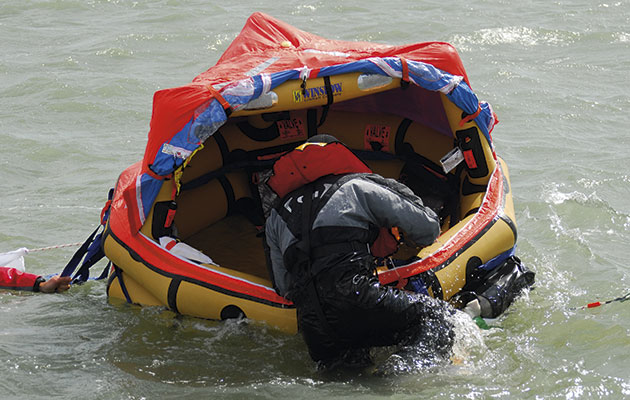
Boarding: The Winslow had the largest and best boarding ramp, with great hand-holds in all the right places. There is a second boarding ramp with a webbing scramble net

Buoyancy: Exceeded the 25cm freeboard minimum by 9cm and maintained positive buoyancy well with one tube deflated
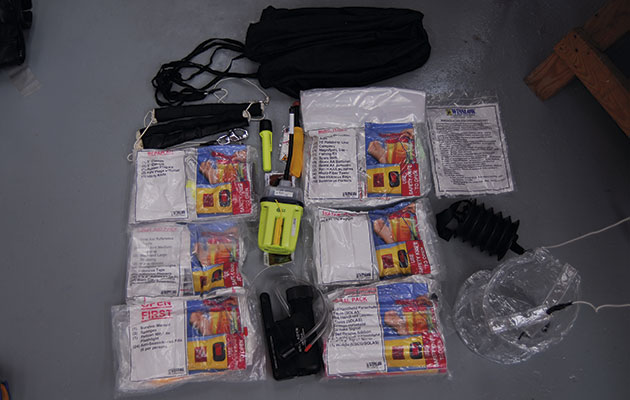
Equipment: All the survival equipment (from the over-24hr survival pack) was well-stowed and clearly marked with pockets for everything. Rescue equipment was kept in pockets near the door and rations in pockets at the back. Except for the paddles, which could have been bigger, spec was impressive – stainless steel swivels at either end of the drogue, a spare drogue, an EPIRB, a hand-operated reverse osmosis desalinator, a laser pointing light for attracting attention from passing vessels and lines to tie up ballast bags to reduce drag when sailing or wind-drifting the liferaft
Independently tested:
No, but Winslow is accredited by the American Federal Aviation Administration (FAA).
Manufacturer’s comments:
Inflation takes a little longer because of the liferaft’s arches and oversized buoyancy. Our ballast bags are retractable so we have kept the paddles small, but the liferaft can still be paddled. The paddles have reflective tape, so that they can be used for signalling to aircraft.
Data panel
Weight: 39kg
Dimensions: 81x46x23cm
Does it meet the standard?
6.2 LAUNCHING
Pulls on painter: 1
5-min float: Yes
Inflate to shape: 16 secs
Fully inflate: 30 secs
5.2.1.2 PROPERTIES OF PAINTER
At entrance: Yes
1m indicator: Yes (flag, retro tape)
Easy to fire: Yes
5.2.3.1 NUMBER OF COMPARTMENTS
2
5.2.5.4 BOARDING FROM A HEIGHT
Damage: None
6.5 RIGHTING TEST
Time: 3 secs
6.6 BOARDING TEST
Time: 6 secs
5.2.3.2 CARRYING CAPACITY
Sufficient comfort and headroom Yes
5.2.3.3 FREEBOARD
>250mm with four crew Yes (340mm)
5.2.4.1 STABILITY GENERAL
3-knot tow with four crew Yes (Very good)
5.2.3.4 FLOODING RESISTANCE
Positive freeboard with one flat tube Yes
5.2.8.3 EQUIPMENT (<24HRS)
Pass
Seago Self-Righting ISO 9650
Launching: The painter required five firm tugs before the liferaft inflated. The Seago had the longest inflation times. The painter is attached below a small observation port.

Righting: Once inflated, the liferaft righted itself quickly but one of the thermal-insulating floor panels floated free

Boarding: The ladder steps floated so they had to be held down to get a foot on the rungs. The ballast bags seemed ineffective and lifted out of the water, sinking the flimsy boarding ramp when we attempted to board and very nearly capsizing the liferaft. The survival equipment stored at the entrance hampered access to the boarding aid inside

Inside: The liferaft was more cramped than the others because of the inflatable thwarts and arches that make it self-righting. The Seago’s sea anchor was not as effective as the others

Buoyancy: Freeboard was too close to the 25cm minimum for our tester to pass or fail the liferaft. It retained positive buoyancy with one tube deflated but one of the arches deflated, too, severely limiting headroom in one half of the liferaft
Equipment: Survival equipment was stowed in a haphazard way but liferaft repair clamps were included instead of the usual glue and patches.
Independently tested:
Yes, by Germanischer Lloyd.
Manufacturer’s comments:
We will be reviewing all aspects of this test with the manufacturer to incorporate the issues raised.
Data panel
Weight: 43kg
Dimensions: 70x29x45cm
Does it meet the standard?
6.2 LAUNCHING
Pulls on painter: 5
5-min float: Yes
Inflate to shape: 20 secs
Fully inflate: 56 secs
5.2.1.2 PROPERTIES OF PAINTER
At entrance: Yes (not main entrance)
1m indicator: Yes (but light coloured and only on one side)
Easy to fire: Yes
5.2.3.1 NUMBER OF COMPARTMENTS
2
5.2.5.4 BOARDING FROM A HEIGHT
Damage: None
6.5 RIGHTING TEST
Time: Self righting
6.6 BOARDING TEST
Time: 35 secs (ave)
5.2.3.2 CARRYING CAPACITY
Sufficient comfort and headroom Yes
5.2.3.3 FREEBOARD
>250mm with four crew – (too close to pass/fail)
5.2.4.1 STABILITY GENERAL
3-knot tow with four crew Yes (Good, wet)
5.2.3.4 FLOODING RESISTANCE
Positive freeboard with one flat tube Yes (half canopy deflated, reducing headroom)
5.2.8.3 EQUIPMENT (<24HRS)
Pass
Three vital issues affecting you
The phrase ‘you get what you pay for’ for seems tailor-made for this test and we recommend paying as much as you can comfortably afford because you can’t put a value on your life and those of your loved ones. At the premium end, the Winslow is impeccably specified and equipped, and – at £4,824 – you’ll pay handsomely for that peace of mind. The budget Seago – costing £949 – does just enough to scrape over the standard’s bar. In the mid-range, Viking has been making commercial liferafts for years and the company’s expertise is reflected in the quality
of the materials used, the build, the testing and servicing of its liferafts.
However, our test raised three other important issues with the ISO 9650 standard, which we believe should be addressed. They are:
- Liferaft servicing
- Independent testing
- Sea survival training
Liferaft service in USA could have ended in death
One horror story, which illustrates why it’s vital to check your liferaft supplier’s service network, came from a YM reader. His liferaft accidentally inflated in his yacht’s cockpit, bursting a locker, while the yacht was berthed in Florida. He telephoned the UK manufacturer (one that chose not to take part in our test), which recommended a service agent nearby. Our reader had his raft serviced, collected it, completed his cruise and set off home across the Atlantic. When he took the liferaft in for a UK service, he learnt that the survival pack had not been serviced and was a year out of date, and that the inflation valve had been replaced incorrectly. Had his yacht foundered, the raft would have deflated beneath him and he and his family may well have died.
Plastimo has a good set-up with regular inspections and intensive training. As the manufacturers of both SOLAS and leisure boat liferafts, Viking and Ocean Safety’s service arrangements are tightly controlled and regulated. This ensures that their staff training is up-to-date.
Why the RYA is testing liferafts
There have been problems with ISO 9650 accreditation. First, there’s no standard testing body, which raises questions over the consistency of testing. Secondly, because the test is of a simple ‘tick-the-box’ variety, liferafts are being built to the letter of the standard, but missing its spirit completely. One manufacturer, who did not want to take part in our test, satisfied the paddles requirement of ISO 9650 by providing what looked like a pair of children’s beach spades. The RYA has now set itself up as a body that can test liferafts against every aspect of ISO 9650. The aim is to standardise testing, remove inconsistency and encourage manufacturers to focus more on the spirit rather than the letter of the ISO standard. If the liferaft complies, the RYA awards a compliance ‘Tickmark’ – reassurance that the liferaft is fit for purpose. As the RYA is non-profit-making, manufacturers should pay less for testing.
Why liferaft survival training is essential

The RYA Basic Sea Survival course is a fun weekend with a serious purpose. It is strongly recommended
Your first experience with a liferaft should not be an emergency. The RYA Basic Sea Survival course gives you a weekend of hands-on experience – swimming in oilskins and working as a team to launch, right, board and manage a liferaft. You’ll learn a lot, and it’s great fun. Visit www.rya.org.uk for your nearest training centre.





